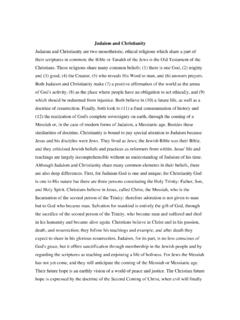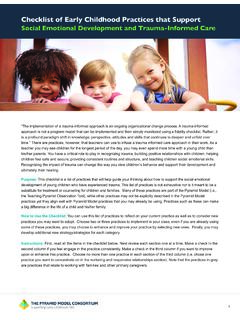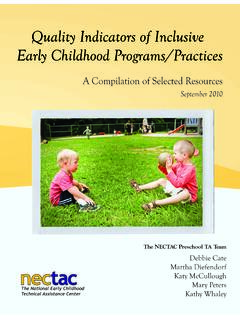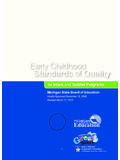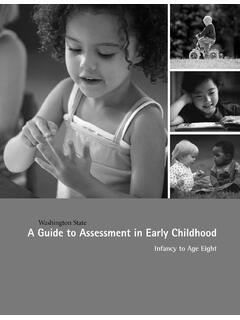Transcription of Universal Design for Learning (UDL) Checklist for Early ...
1 1 Universal Design for Learning (UDL) Checklist for Early childhood Environments Universally Designed Learning (UDL) environments are designed from the onset in consideration of the widest diversity of learners possible so that all children benefit. The UDL environment is designed by considering cultural, linguistic, and ability diversity among all children. These environments provide for UDL practices that assist in developing inclusive Early childhood environments to ensure equitable access and meaningful participation through flexible, engaging, and creative approaches within a developmentally appropriate setting. Following is a UDL Checklist developed to guide Early childhood observations through the lens of Universal Design for Learning . The outcomes identified from using this tool can be reviewed to create greater UDL awareness, highlight currently used UDL practices , and acknowledge areas to strengthen UDL policies and strategies within the Learning environment. The UDL Checklist is intended to offer a brief snapshot of UDL perspectives to support the expansion and strengthening of UDL.
2 For additional UDL related resources and information, visit the Building Inclusive Child Care (BICC) website at UDL Checklist Questions Universal Design for Learning (UDL) is based on three principles that focus on providing multiple and varied approaches to Learning and can be phrased for purposes of this observation tool, by asking the following three questions. Use these broader UDL related questions in conjunction with the questions in the categories of Curriculum, Physical Environment, and Relationships when conducting the UDL observations. The Checklist questions and examples are intended to guide educators to think differently and to concentrate on the intentionality of teaching as a way to Design and implement quality Learning experiences in diverse Learning environments. 1. Does the Early childhood environment provide all children with multiple and varied ways to learn? (UDL Principle # 1- providing multiple means of presentation to give children a variety of ways to acquire, process, and integrate information, knowledge, and skills) 2.
3 Does the Early childhood environment provide all children with multiple and varies ways to express and show what they are Learning ? (UDL Principle # 2 providing multiple means of expression to give children a variety of ways to show or demonstrate what they are Learning ) 3. Does the Early childhood environment provide all children with multiple and varied ways to become engaged, motivated, excited, and challenged in their Learning ? (UDL Principle #3 providing multiple means of engagement to give children varied opportunities to be motivated and challenged) 2 Curriculum Inquiry Curriculum must be responsive to culturally, linguistic, and ability diverse Learning environments. Educators must acknowledge and respect diversity among learners and share a commitment that all children will have equitable access to a curriculum that will provide meaningful participation, benefit, and supports. Teaching Strategies & Learning Outcomes 1. How are sensory, motor, culture, linguistic, and ability diverse considerations made within the curriculum?
4 Are multiple Learning structures provided (individual, small group, whole group opportunities)? How are higher level thinking experiences provided within the range of diversity? 2. Do children have multiple opportunities for exploring, Learning , and communicating (receptively and expressively) through varied approaches (modeling, prompting, sign language, braille, use of pictures, symbols, graphic organizers, role play, the arts , assistive technology)? 3. Are opportunities provided for children to begin Learning experiences, pause, and continue at a later time? How does the environment respond and support children s varying energy levels, health conditions, attention spans, or interests? 4. Is consideration given to the "timing" of children's responses (flexibility given to the pace of an activity, providing adequate time for children to respond; use of assistive technology to assist with memory and communication in responding)? 5. Is "partial participation" used as an inclusive strategy?
5 Are expectations for participation and performance varied? Example: If children are listening to a story and are asked to recall events, some may attend to and repeat back key words, others may recall names of characters by pointing to pictures or using signs and gestures, others may predict what will happen next using complete sentences. 6. Is Learning content presented in multiple formats (verbal, visual, print, video, tangible objects, technology) and meets the cultural, linguistic, and ability diverse needs of children (child s primary type and use of communication)? 7. How are transitions handled (verbal, visual, music)? Are children given indications before transitions happen (dimming of lights, playing of soft music)? Are routines consistent, flexible, and responsive to changing needs of children (easily identifiable and accessible schedule)? 8. Does the classroom provide efficient and effective use of existing staff/teachers? If a child needs direct (individual or one-to-one assistance) is someone able to provide it?
6 If not, how can the Learning environment be structured in advance so that appropriate supports are available? What additional supports or local resources might be available to support UDL and inclusive practices ? How can the environment and personnel increase flexibility to change? 9. How are children given opportunities to initiate Learning that reflects their unique interests, strengths, and motivations (emergent curriculum, child-centered Learning )? 10. Are student Learning outcomes demonstrated in multiple ways that reflect cultural, linguistic, and ability diversity? 3 11. Are children encouraged to use multiple and different ways to respond within the Learning environment and express their Learning (pointing, vocalizing, manipulatives, eye gaze, signing, braille, writing, artwork, song, technology)? Physical Environment Inquiry All children must be able to safely access and actively engage in the Learning . Layout 1. Does the environment provide for easy, safe, and independent access to activities, spaces, equipment, and materials?
7 2. Are there clear, wide paths for safe and easy movement? Would it be possible for a child with limited mobility (using a walker or wheelchair) to easily get to the classroom, move around within the classroom, and access/participate in an outdoor playground and other Learning environment areas? How might access be improved? Does the physical Learning environment provide Universal access (access for all)? 3. Is a safe and accessible floor covering used (for children who are on the go , those using wheelchairs, with visual impairments)? 4. Are varied seating options used (floor, mats, cushions, chair, or specialized seating)? 5. Is there a place in the environment where children can rest during the day and/or experience reduced noise levels (reading area with pillows; use of headphones)? 6. What sensory related environmental considerations are made (noise, lighting, over visual stimulation on walls and spaces)? Materials 1. Are materials and Learning resources varied and diverse (items of different sizes, textures, shapes, varying accessibility) for easier manipulation and handling?
8 2. Are teacher made and/or inexpensive materials used to demonstrate creativity and flexibility (paper clips or clothes pins to turn pages, raised line paper made with glue, cleaning or scrub brushes for painting, etc.)? 3. Are materials available that reflect diverse family, linguistic, and cultural experiences? 4. Is there use of multiple types of equipment, materials, songs, games, toys, books, computer software, to provide each child with equal access and meaningful participation around Learning concepts (literacy, math science, social skills, and other Early Learning knowledge and skills)? 4 Relationships Inquiry Collaboration between all individuals associated with the child's Learning is essential for developing and maintaining positive relationships (families, teachers, therapists, Early intervention personnel). 1. What are the multiple approaches used for welcoming all children and families? How is cultural, linguistic, and ability diversity considered? 2. Are family goals and preferences for each child considered?
9 How are these goals and preferences shared? (written, verbal, formal, informal, scheduled, spontaneous)? 3. Do all staff/teachers have access to IFSP/IEP s? Does the IFSP/IEP process provide flexibility and meaningful family participation? 4. Are multiple approaches used for communications between families and teachers/staff? 5. How are all children given opportunities to understand, express, and respect personal feelings (verbal, written, technology, song, journaling) and in the context of cultural, linguistic, and ability diversity? UDL Checklist Examples The following are selected examples to guide the observer in exploring the use of multiple and varied Learning approaches within the context of Universal Design for Learning (UDL). The Checklist examples provide only a sample of items intended to initiate thinking and planning for UDL practices as a way to provide quality inclusive education for all children. 5 Use of quiet verbal & visual communication (gestures, sign language) Non-verbal transition indicators (lights, music) Levels of prompting (verbal, modeling, physical) Multiple positive guided practice opportunities Easily identifiable routine (pictorial, symbolic) Variable groupings (whole, small, peer, one-to-one) Pace of activity (responsive to energy level, health needs, thought process) Presentation of content in multiple formats Same Learning experience, different focus (partial participation) Encouragement of varied response modes Balance of adult and child-initiated tasks Exploratory play with materials and ideas/emergent curriculum Opportunity to begin Learning experiences and return at a later time Use of songs, stories, dramatic play, and art to express emotions (responding to pictures, role play)
10 Equal access to Learning content area activities Learning through peer interaction Developmentally appropriate practices Opportunity to show what they know in various ways Development & implementation of IFSP/IEP goals and objectives Diverse assessment methods Curriculum Inquiry Curriculum must be responsive to culturally, linguistic, and ability diverse Learning environments. Educators must acknowledge and respect diversity among learners and share a commitment that all children will have equitable access to a curriculum that will provide meaningful participation, benefit, and supports. Teaching Strategies Learning Outcomes 6 Physical Layout Quiet area for rest/therapy Safe and accessible areas (wide pathways, uncluttered floor, indoor/outdoor floor covering) Access to classrooms Moving within classrooms (to activities) Playground Sensory - low noise level/minimal visual stimulation Accessible activities and equipment Varied seating options (floor, mat, cushion) Frequent & diversified home/school communication (daily log, verbal, electronic) Knowledgeable, flexible, trained staff (emergencies, continuing education, UDL, diverse families) Collaboration with various personnel, families IFSP/IEP access, flexible process Materials Creative and flexible materials (non-roll crayons, textured balls, paperclip, clothespin page turners) Inclusive curriculum materials (variety of toys, books, music, posters reflecting cultural, linguistic, ability diversity)


